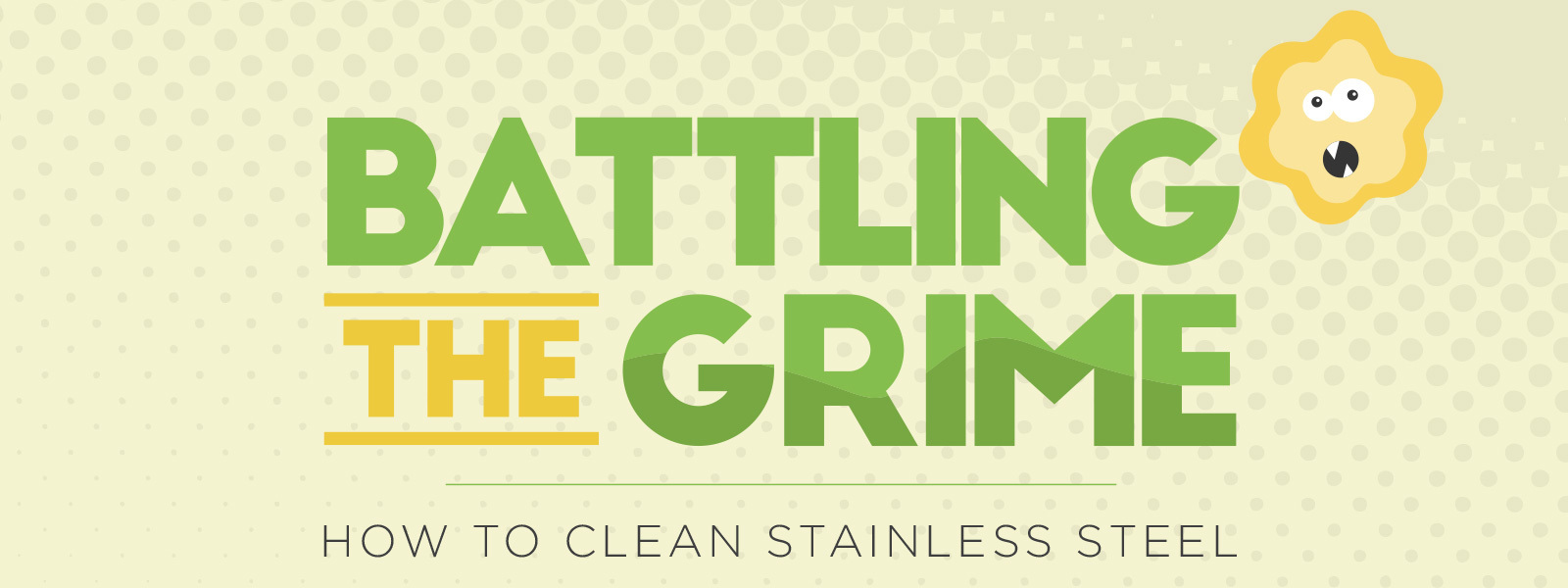Battling the Grime: How to Clean Stainless Steel
It is an ever-present fight, the one between the restaurant owner and germs, and it doesn’t stop on the battlefront of stainless steel. There’s hope for winning this war though, all it takes is the right tools and the know-how to use them. So, gird yourself, and check out this battle plan for how to clean your stainless steel appliances.

It is an ever-present fight, the one between the restaurant owner and germs, and it doesn’t stop on the battlefront of stainless steel. There’s hope for winning this war though, all it takes is the right tools and the know-how to use them. So, gird yourself, and check out this battle plan for how to clean your stainless steel appliances.
Stand Guard for Later Invasions
Now that you know how to properly fight the gunk, it’s time to take some precautions. Here are other things which can hurt your stainless steel:
- Blood from meat products
- Acidic foods
- Saltwater
- Wet metal left on stainless for a long period of time
Don’t worry, the things on this list can still come in contact with stainless, just be sure to clean your surface directly afterward.
Here would be a good place to note that this guide is on the topic of cleaning and taking care of your stainless steel only. You’ll need to follow up with your state’s proper sanitation and disinfection procedures before using a surface for food service. You can find guidelines on the U.S. Drug and Food Association’s website.
Gather Your Weapons
| What to Use for the Everyday Battles: | What NOT to Use: |
|---|---|
| Hot Water: The heat in the water breaks down grease better than cool water. Just make sure its not hot enough to burn your hands. You need those. | Scouring/Brillo Pads: When stainless steel is scratched, it tends to rust. Scouring pads will shred the top layers of the stainless, making cozy indents for rust. |
| Microfiber Cloths: Of course, you can use paper towels, but these are rougher and may result in fine, yet visible, scuffing. Instead, use microfiber cloths. They are softer, reusable, and engineered to capture and remove grime and bacteria. | Steel Wool Pads: Not to be confused with stainless steel wool which can be used. Steel wool pads are like metal brushes, and when you use them, they leave behind particles in the stainless which can cause rust quite quickly! |
| Disinfecting Cleaner: While some disinfectants, such as chlorine bleach, can damage stainless steel, there are many safe-for-stainless sanitizers. Iodine compounds known as "iodophors", ammonia-based cleaners, and alkaline sanitizers can all be good options. Ammonia-based disinfectants are always a safe bet. | Abrasive Cleaners: Cleaners made with chlorine, fluorine, and other chemicals known as halogens are effective disinfectants because these "halides" are oxidizers. Unfortunately, the same chemicals that obliterate bacteria may also cause your stainless to stain and rust. Avoid these cleaning agents. |
| What to Use When the Grime is Really Winning: | |
| Stainless Steel Wool Pads (+Dish Soap): Only use stainless steel wool if there are brown stains on your countertop. It's a strong abrasive. You won't need to use it every time you clean, but to really get the gluey stuff, this is your Excalibur. | |
| Stainless Steel Cleaner/Polish: For a solid wipedown and finishing polish, try using stainless steel cleaner/polish. Just make sure that if you're polishing a food surface, to check the label and be sure it's food safe. |
Attack!
Defense #1: Standard Cleaning
- Start of by spraying the appliance down with the glass cleaner.
- Much like wood, stainless steel has a grain, so using your microfibre cloth, clean in the direction of the natural striation. Rubbing against it may eventually cause rust.
- Now, dry the whole thing off. Dry, dry, dry!
Defense #2: Heavy Scrub
- With hot water, dish soap, and your stainless steel wool, scrub the stains with stainless steel wool (along the grain of the stainless steel of course). After giving it a good wash, rinse with warm water.
- Take a little bit of the stainless steel cleaner/polish and give it a gentle buff. You’ll know if you’ve used too much polish if the surface becomes slick and sooty. The trick is to use just enough to get the stainless steel to gleam with a rich sheen.
- Rinse and repeat step #1.
- Taking a clean cloth or towel, dry the entire thing. No water droplet left behind.
So, there it is – or as the French would say, “Viola!” Your stainless steel will last years longer when you give it the love it deserves. Are there other ways you clean stainless steel? We’d love to hear them, just post in the comments below.
*The Association of Official Analytical Chemists defines sanitizing for food prep surfaces as a process which reduces contamination by 99.9% in 30 seconds.
Disclaimer: We’re a knowledgeable bunch, but the exact definition of proper sanitation for commercial food establishments varies from state to state. Please check this article against your state’s Department of Health standards. Any failure to meet these standards is not the responsibility of this article or PRIMA, LLC.




